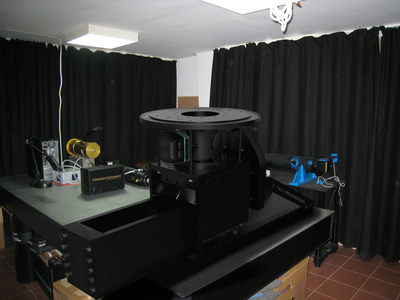Contact Details:
Flowcrete
176 Voortrekker Street
Jacobs
Durban
Kzn
4052
South Africa
Tel: +27 (0)31 461 3411
Fax: +27 (0)31 461 3475
Send Enquiry | Company Information

High Performance Lenses for State-of-the-Art Wide Field Imager
Product News Thursday, September 8, 2016: Flowcrete
Optical Surfaces Ltd. has supplied to the National Observatory of Athens (www.astro.noa.gr) a series of high precision lenses designed for a new state-of-the-art wide field imager that will extend the capabilities of its 2.3m Aristarchos Telescope.
The Aristarchos Wide-Field Camera (AWFC) is a new state-of-the-art wide field imager** which will be used on the 2.3m Aristarchos telescope at the Helmos Observatory in Greece. It has a 26 x 26 arcmin field of view on the sky with a resolution of better than 1 arcsecond per pixel. The AWFC will be used for SDSS imaging and calculation of precise photometric redshifts of objects (e.g. Supermassive Black holes in Active Galactix Nuclei) in sky fields covered by the ESA/XMM satellite and high resolution narrow-band imaging of large filamentary structures, including Supernova Remnants and Planetary Nebulae which are the end points in the life of stars. For the latter, the AWFC will provide unique information about their structure and morphology which will help significantly to study their kinematics and dynamics together with subsequent spectroscopic observations. The wide field imager has been manufactured and is in its testing phase in the optical lab. Commissioning of the AWFC on the 2.3m Aristarchos telescope and first light is expected in 2017.
Because of its international reputation for supplying high precision telescope optics, the National Observatory of Athens (NOA) selected Optical Surfaces Ltd. to manufacture and supply an 160 mm diameter Field Lens and a Collimator lens assembly, comprising a cemented doublet, a meniscus lens and a biconvex lens. All these high precision AR coated lenses were designed to perform well over a wide range of wavelengths, in order to maintain the high performance and achromatic nature of the reflective optics of the Aristarchos telescope but over a much wider field of view.
Dr Panayotis Boumis, a senior researcher within the NOA, said "Selecting a supplier to help design and manufacture these lens assemblies was a very important decision because of the critical role that they will play in extended the capabilities of our 2.3m Aristarchos telescope. Throughout the project - Optical Surfaces provided us with a wealth of valued technical input demonstrating their extensive experience and knowledge in the area of designing high precision optics and lens assemblies for telescopes".
Dr Aris Kouris, sales manager at Optical Surfaces Ltd. commented “We are pleased to have been selected by the NOA to have provide advice on the final design of the lenses to extend the performance of their 2.3m Aristarchos telescope. Drawing upon over 50 years’ experience in telescope optics design and manufacturing we were able to come up with easily manufactured lens designs that delivered the required high performance whilst maintaining cost competitiveness. This is the second time that we have worked with the NOA and are happy that we have been of help once again for such an important project and customer".
Optical Surfaces Ltd. has been producing optical components, mounted optical components and systems for more than 50 years and is now accepted as one of the world’s leading manufacturers of high precision optics for ground and space based telescope systems. The company’s ISO 9001-2008 approved manufacturing workshops and test facilities are deep underground in a series of tunnels excavated in solid chalk where temperature remains constant and vibration is practically non-existent. With such stable conditions, testing, particularly with long path lengths, becomes quantifiable and reliable. Working with these natural advantages is a highly skilled team of craftsmen with a commitment to excellence in both product quality and customer service.
The Institute for Astronomy, Astrophysics, Space Applications and Remote Sensing (IAASARS) is one of the three institutes of the NOA. The main activities of the Institute involve basic and applied research in a number of topics in astrophysics, from distant galaxies to the solar neighbourhood, as well as ground based and space-borne remote sensing, earth observation and signal processing. The institute is also committed to outreach and science dissemination for the general public and operates a very popular visitor centre in Penteli. For further information relating to the work carried out by the NOA and the 2.3m Aristarchos telescope please visit http://helmos.astro.noa.gr/.
